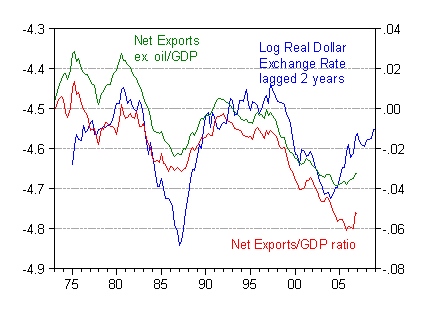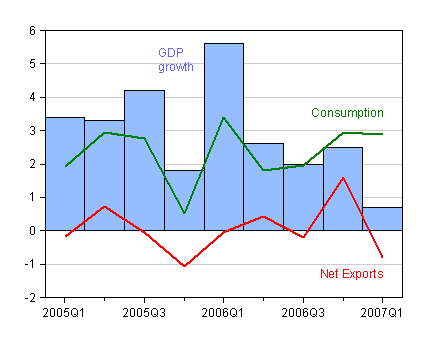As worries from ever expanding — but always containable — housing and mortgage market collapse mount (see this Reuters article), some analysts believe that the external accounts will save the day. From Bloomberg (July 23):
Dollar Bear Market Slide More Boon Than Bane for Bush (Update1)
By Bo Nielsen
July 23 (Bloomberg) — Everyone from Nobel Prize laureates to the world’s biggest bond investor says the Bush administration has reason to cheer the dollar’s slide to historic lows.
The currency has lost 13.2 percent since January 2001, when George W. Bush took office, the most under any president since at least Gerald Ford, who left the White House in 1977. That’s based on a Federal Reserve index that tracks the dollar against the currencies of 38 U.S. trading partners, including Germany, Japan and Canada.
A weaker dollar is helping the economy and may bolster voters’ confidence in the Republican party as the U.S. heads into a presidential election year. Rather than causing foreigners to flee U.S. securities, the depreciating currency is making American goods less expensive abroad and helping offset the worst housing recession in 16 years. Exports reached an all- time high of $132 billion in May, the government said this month.
“The early line of the George Bush administration was that we want a strong dollar,” said Paul Samuelson, the 1970 recipient of the Nobel Prize in economics and professor emeritus of economics at the Massachusetts Institute of Technology in Cambridge, Massachusetts. Over time “they began to want a depreciated dollar,” he said.
Treasury Department data going back to 1978 show that every administration except Bush’s entered the foreign exchange market to buy dollars in an attempt to support the currency.
No Change
Treasury Secretary Henry Paulson’s stance hasn’t changed since he said in May that “a strong dollar is in our nation’s interest and that our currency rates, like all currency values, should be set in a competitive marketplace, based on economic fundamentals,” according to Brookly McLaughlin, a spokeswoman. The Treasury has stuck to its strong-dollar mantra for the past decade.
The dollar set a new low of $1.3845 per euro today, and is the weakest in 26 years versus the British pound. A U.S. tourist heading to England will pay more than $2 for one U.K. pound, up from about $1.65 at the end of 1997. Against the Canadian dollar, it’s the lowest since 1977 and it’s the weakest in seven years versus Brazil’s real.
“A weak dollar is in the interest of the United States and in fact the world economy,” as a means of spurring demand for U.S. goods at home and from abroad, said Jan Hatzius, chief U.S. economist at Goldman, Sachs & Co. in New York.
…
International Appetite
The decline in the dollar has helped trim the U.S. trade deficit. The shortfall in the current account, the broadest measure of trade, has shrunk to $192.6 billion in the first quarter, equivalent to about 5.7 percent of the economy, from a record 7 percent in 2005.
Treasury officials have complained the dollar is too strong compared with the currency of China, which accounted for 30 percent of the U.S. trade deficit in 2006. The Treasury last month called the yuan “undervalued.”
The 13.2 percent tumble under Bush compares with a 18.3 percent gain under Bill Clinton and declines of 0.2 percent under George H. W. Bush, 0.4 percent under Ronald Reagan, 3.0 percent under Carter and 2.3 percent during Ford’s tenure, the Fed’s U.S. Trade-Weighted Real Broad Dollar Index shows.
The dollar’s drop hasn’t dented international investors’ appetite for U.S. securities. They added a record $126.1 billion in May, Treasury data showed last week. The prior monthly record inflow was $120.9 billion in August 2006.
The currency may end the year at $1.36 per euro, according to the median forecast of 36 analysts in a Bloomberg News survey published July 9.
I have some problems with the idea that most of the improvement in the trade balance has been due to the depreciation of the dollar. Certainly some of it is. But the recent improvement is due in large part to the acceleration in growth in the rest-of-the-world, the slowdown in U.S. growth in 2007Q1 (although see here). And a very large chunk of the improvement in 2007Q1 was due to the drop — now done with — in oil prices.

Figure 1: Log real broad trade-weighted dollar exchange rate lagged two years (blue, left scale; higher is weaker), net exports to GDP ratio (red, right scale), and ex-oil net exports to GDP ratio (green, right scale). Source: Federal Reserve Board, BEA (June 28 release), and author’s calculations.
Indeed, as I’ve pointed out before, the improvement in the trade balance has lagged the two year lag that typically is associated with dollar depreciations. But even allowing for some sort of peculiarly long lag structure, the positive contribution to GDP growth is something of the past.

Figure 2: Growth rate of real GDP (blue bars), and contribution to real growth from net exports (red), and consumption (green), in percentage points SAAR. Source: BEA (June 28 release).
That is, the peak effect was 2006Q4 (see also Brad Setser’s discussion). The effect in 2007Q1 was negative. Indeed, what pulled overall GDP growth into the black was consumption growth. And it is exactly consumption growth that is apparently faltering, perhaps because of the weakening housing market.
On the other hand, Deutsche Bank (US Economics/Strategy Weekly, July 13) argues:
Net exports should stabilize, if not improve somewhat Export growth slowed to just a 0.7% annualized rate in Q1, possibly payback for a substantial 10.6% increase in Q4 2006. Over the last year, exports are up a healthy 6% in real terms, about three times as fast as the growth rate of the overall economy. This gain is likely to be maintained, if not accelerate, in the months immediately ahead in light of the strong global economy and the latest macroeconomic data. For instance, the level of April exports is up nearly 6% (annualized) relative to its Q1 average, and the new export orders index in the ISM survey recently registered its highest reading in over three years. Exports are likely to be the one bright spot for the economy. Moreover, with consumer spending projected to moderate in the second half of the year, import growth is likely to slow.
So it may be that 2007Q2 will show a resumption in growth attributable to net exports. We’ll see on Friday.
Technorati Tags: net exports,
trade deficit,
dollar,
exchange rate,
GDP,
recession.
.
Minzie wrote:
I have some problems with the idea that most of the improvement in the trade balance has been due to the depreciation of the dollar. Certainly some of it is. But the recent improvement is due in large part to the acceleration in growth in the rest-of-the-world, the slowdown in U.S. growth in 2007Q1
Thanks professor. Spot on with this comment.
While there may be some increase in exports as the dollar devaluates it is on the backs of the people so it is a double edged sword. Exporters and foreign consummers are subsidized by US workers as their dollar shrinks in purchasing power.
Professor, the improvement in net exports in Q2 07 will not offset the reduction in personal consumption and residential investment.
My extrapolations and calculations are for 1.4% growth in Q2 07 GDP.
We’ll see tomorrow morning.
Professor, I was wrong and you were right, that exports (along with government spending and non-residential investment) were enough to offset the weak consumer spending.
jg: Well, maybe you’re wrong and maybe I was right. I wasn’t sure myself what BEA would say about net exports (it turned out to be 1.18 percentage points positive contribution). It’s important to remember that the advance release of GDP is based upon estimates of the June trade figures. Those figures won’t be released until August 14th.
By the way, notice that consumption provided only 0.89 percentage points of the overall 3.4 percentage points overall GDP growth.